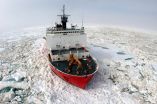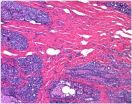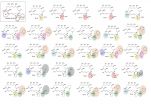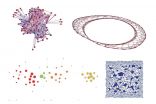(Press-News.org) In the depths of the Arctic Ocean, buried deep in the sediment, an ancient creature waited for over a million years to be discovered. Paul Valentich-Scott, from the Santa Barbara Museum of Natural History (California), and three scientists from the United States Geological Survey (USGS, Menlo Park, California), Charles L. Powell, Brian D. Edwards, and Thomas D. Lorenson were up to the challenge. Each with different expertise, they were able to collect, analyze, and identify a new genus and new species of bivalve mollusk.
The path to discovery is seldom simple or easy. This discovery is no exception. Brian Edwards was the chief scientist on a joint US-Canadian ice breaker expedition aboard the US Coast Guard Cutter Healy in the summer of 2010. The primary purpose of the expedition was to map the Arctic seafloor and the sediments beneath. Dr. Edwards took deep sediment core samples to further understand the geology of the region including the unusual seafloor mound where these samples were collected. In several of these cores he uncovered bivalve seashells buried nearly 15 feet (4.5 m) below the seafloor surface.
Upon returning to his USGS laboratory in Menlo Park, California, Brian worked with Tom Lorenson on sampling the cores and extracting the shells. The recovered shells were then taken to USGS paleontologist Chuck Powell, for identification. While Chuck was able to ascertain the higher level classification of the clam shells (Family Thyasiridae), he was unable to determine the genus or species. Chuck contacted Paul Valentich-Scott, a clam specialist from the Santa Barbara Museum of Natural History in California.
When examining these ancient shell specimens, Paul was fairly certain that they were new to science. The hunt to validate the potential new species was on. Paul contacted a number of thyasirid bivalve specialists around the world and all gave it a thumbs up as a new species. Further, several scientists felt it also might be a new genus (the level above species).
'It is always exciting when you are the first person to be looking at a new creature' declared Valentich-Scott. 'While I have been fortunate to discover and describe many new species in my career, it is always exhilarating at the outset.'
Then the painstaking work began. Paul contacted museums around the globe and requested to borrow specimens that were potentially related to the new species. While he found many species that shared some characteristics, none matched the new Arctic specimens.
The four scientists have been writing up their findings for the past two years and now the work has been published in the international science journal ZooKeys.
The new genus and species is named after two individuals. The genus is named in honor of Dr. Thomas R. Waller a prominent paleontologist at the Smithsonian Institution. The suffix "concha" meaning shell, is combined to create the name Wallerconcha. The new species is named after Sara Powell the daughter of co-author Chuck Powell. Chuck was quick to mention "I want to name new species after all of my children."
While many of the specimens collected were definitely fossils, the scientists can't discount the new animal might still be alive today. One of the team members, Tom Lorenson, summarized it this way 'The likely collection of living specimens of this species awaits expeditions to come.' Who knows what other new creatures might be found in those expeditions?
INFORMATION:
Original Source:
Valentich-Scott P, Powell II CL, Lorenson TD, Edwards BR (2014) A new genus and species of Thyasiridae (Mollusca, Bivalvia) from deep-water, Beaufort Sea, northern Alaska. ZooKeys 462: 11-26. doi: 10.3897/zookeys.462.6790
Breast cancer is the most common in women. One in nine will suffer breast cancer over their lifetime. Progress in prevention and early detection, and the use of chemotherapy after surgery (adjuvant chemotherapy), have achieved significantly increase survival in this disease in the last ten years, but much remains to be done.
The identification of patients with high-risk breast cancer is key to knowing whether a patient will require only the removal of the tumor by surgery or whether if she will need additional chemotherapy to make sure the removal of breast cancer cells. ...
Malaria is one of the most serious health problems worldwide, registering 200 million clinical cases and more than 600,000 attributable deaths per year, according to information from the World Health Organization in 2013. Given the emerging resistance to the standard treatment most widely used throughout the world, which is based on artemisinin and its analogs, there is a need for new antimalarial compounds.
In this regard, scientists headed by Lluís Ribas de Pouplana, ICREA researcher at the Institute for Research in Biomedicine (IRB Barcelona), report on a new ...
This news release is available in German. FRANKFURT. Frankfurt physicists have once again contributed to resolving a disputed matter of theoretical physics. Science has long since known that, contrary to the old school of thought, helium forms molecules of two, three or even more atoms. Exactly what helium consisting of three atoms looks like, however, has been disputed by theoretical physicists for about 20 years. Besides the intuitive assumption that the three identical components form an equilateral triangle, there was also the hypothesis that the three atoms are ...
Patients suffering from the world's most common heart rhythm disorder can have their long-term outcomes significantly improved with an aggressive management of their underlying cardiac risk factors, according to University of Adelaide researchers.
Atrial fibrillation (AF) is increasingly responsible for dementia, stroke and death, and has a significant impact on healthcare costs. With electrical "short circuits" believed to be responsible for the abnormal beating of the heart in AF patients, one currently used treatment is to burn the tissue surrounding the problem area, ...
Mammals that lived during the time of the dinosaurs are often portrayed as innocuous, small-bodied creatures, scurrying under the feet of the huge reptiles. In reality, this wasn't the case, and a new fossil from Madagascar further underscores this point, revealing fascinating perspectives on the growing diversity of Mesozoic mammals. Vintana sertich had previously been described in a preliminary note in November of this year, but a new memoir in the Journal of Vertebrate Paleontology delves far deeper into the morphology and paleoecology of this amazing fossil animal. ...
A simple supplement could be a safe and cost-effective way of reducing heart disease in individuals born with a low birth weight, suggests research from the University of Cambridge. The study, carried out in rats, also raises the possibility of developing a blood test to indicate how much damage there is in the aortas of these individuals.
Researchers at the Institute of Metabolic Science fed low birth weight rats a supplement of the molecule co-enzyme Q (CoQ) and found that in those rats that grew quickly after birth, the supplement prevented cells in the aorta from ...
Techniques now used to reconstruct 3D models based on multiple photos of a building, object or scene can also be leveraged to automatically estimate illumination conditions depicted in a collection of photographs, scientists at Disney Research and Université Laval report.
Everyone knows that objects can look markedly different depending on lighting conditions, the physical characteristics of the objects and the angle at which they are viewed. That makes it difficult for photo editors to insert 3D objects into imagery and make them appear as if they are reflecting ...
The Taj Mahal's iconic marble dome and soaring minarets require regular cleaning to maintain their dazzling appearance, and scientists now know why. Researchers from the United States and India are pointing the finger at airborne carbon particles and dust for giving the gleaming white landmark a brownish cast.
Knowing the culprits in the discoloration is just the first step in cleaning up the Taj Mahal. Scientists now must determine where the particles are coming from to develop strategies for controlling them.
"Our team was able to show that the pollutants discoloring ...
New York, NY, December 9, 2014 - Fourteen years after the attack on the World Trade Center (WTC), a case study in the current issue of Annals of Global Health identifies several elements that have had a critical impact on the evolution of the WTC response and, directly or indirectly, on the health of the WTC-exposed population. The case study also recounts and assesses post-disaster monitoring efforts, recent scientific findings from the World Trade Center Health Program (WTCHP), and explores the implications of these experiences for ongoing and future environmental disaster ...
The global spread of Ebola is due to the complex interactions between individuals, societies, and transportation and trade networks. Understanding and building appropriate statistical and mathematical models of these interactions is vital to responding to the challenges of living in a networked world. There are, of course, many other examples of complex networks -- from national power grids and airline networks to social networks, neuronal networks and protein-protein interactions.
In a new study published in the Beijing-headquartered journal National Science Review, ...







